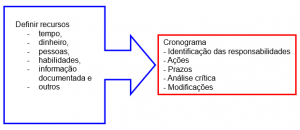[:pb]Qualidade no projeto de produto
Um projeto de produto deve ser concebido e desenvolvido utilizando técnicas que assegurem a qualidade e confiabilidade em todo o ciclo de vida do produto.
Nos anos 60, o controle da qualidade era corretivo. Posteriormente, evoluiu com o aprimoramento das técnicas de inspeção, métodos estatísticos, ensaios de desenvolvimento, relacionados à segurança, desempenho e confiabilidade e ainda trabalhando com o conceito de qualidade total – adequação ao uso e qualidade no projeto.
Alguns fatores que afetam a qualidade são: materiais, tecnologia, máquinas, métodos, pessoas, operadores e gerenciamento (segundo Ishikawa e Feigenbaum).
Num ciclo produtivo, deve-se ter atenção para as seguintes abordagens abaixo, não se limitando apenas a estas:
• Falta de coordenação das equipes que participam das diversas etapas do ciclo produtivo;
• Indefinição das responsabilidades pelas ações de controle;
• Fluxo de informações não rastreável;
• Levantamento incompleto das expectativas e exigências do cliente;
• Falta de suporte pós-venda;
• Falta de monitoramento das competências das pessoas responsáveis pelas funções que afetam a qualidade.
O processo de planejamento de um novo produto deve ter um objetivo bem definido, considerando o seguinte:

O ciclo de vida do produto pode ser apresentado como:
• Fase 1 – Conceitual e Planejamento
• Fase 2 – Projeto e Desenvolvimento
• Fase 3 – Produção
• Fase 4 – Operação e Manutenção (descarte)
Técnicas utilizadas no controle de novos projetos:
Análises do mercado e planejamento do produto;
Análises estatísticas dos novos projetos;
Análises de falhas (modo, efeito e criticidade);
Análises de fatores humanos;
Estudos relativos ao aperfeiçoamento que será realizado em cada uma das características considerando-se os efeitos das mesmas sobre as demais (‘tradeoff studies”). Por exemplo: confiabilidade X complexidade X peso X custo X segurança X performance X consequência das falhas X possibilidade de fabricação X possibilidade de inspeção X possibilidade de manutenção etc.;
Análises do desempenho dos fornecedores de componentes, partes e peças;
Planejar, o que significa analisar previamente a sequência de ações e seguir um roteiro de trabalho proposto para atingir um certo objetivo.
Um planejamento da qualidade bem executado define um roteiro para a empresa entregar produtos novos ou reprojetados, sem defeitos, dentro dos prazos e com custo pré-estabelecido. Este planejamento deve considerar a estrutura organizacional, análise crítica de projeto, ensaios de desempenho, ensaios de confiabilidade, ensaios de segurança, estudo potenciais de ferramental, análise de tolerâncias e certificação do produto.
A NCC tem reconhecimento do mercado em certificação de produtos, profissionais competentes para dar total suporte necessário e avaliar a qualidade de projeto do seu produto.
Material sujeito a mudança (s) em caso de alteração na (s) portaria (s). Publicado em: 13/12/22[:en]A product design must be conceived and developed using techniques that ensure quality and reliability throughout the product’s life cycle.
In the 1960s, quality control was remedial. Subsequently, it evolved with the improvement of inspection techniques, statistical methods, and development tests related to safety, performance, and reliability, and still working with the concept of total quality – suitability for use and quality in the project.
Factors affecting quality are materials, technology, machines, methods, people, operators, and management (according to Ishikawa and Feigenbaum).
In a production cycle, attention should be paid to the following approaches below, not limited to these:
- Lack of coordination of the teams that participate in the different stages of the production cycle;
- Undefined responsibilities for control actions;
- Non-traceable flow of information;
- Incomplete survey of customer expectations and requirements;
- Lack of after-sales support;
- Lack of monitoring of skills of people responsible for functions that affect quality.
The planning process for a new product should have a well-defined objective, considering the following:

The product lifecycle can be presented as follows:
- Phase 1 – Conceptual and Planning
- Phase 2 – Design and Development
- Phase 3 – Production
- Phase 4 – Operation and Maintenance (disposal)
Techniques used in the control of new projects:
- Market analysis and product planning;
- Statistical analysis of new projects;
- Failure analysis (mode, effect, and criticality);
- Human factors analyses;
Studies related to the improvement that will be carried out in each characteristic, considering their effects on the others (“tradeoff studies”). For example, reliability X complexity X weight X cost X safety X performance X consequence of failures X manufacturing possibility X inspection possibility X maintenance possibility, etc.;
Analysis of the performance of suppliers of components, parts, and spares;
Planning, which means previously analyzing the sequence of actions and following a proposed work plan to achieve a specific objective.
Well-executed quality planning defines a roadmap for the company to deliver new or redesigned products, without defects, on time, and at a pre-established cost. This planning must consider the organizational structure, critical analysis of the project, performance tests, reliability tests, safety tests, tooling potential studies, tolerance analysis, and product certification.
NCC has market recognition in product certification and competent professionals to provide full support and assess the quality of your product design.
The material is subject to amendment(s) in case of change in the ordinance(s). Published: 12/13/2022
[:]
